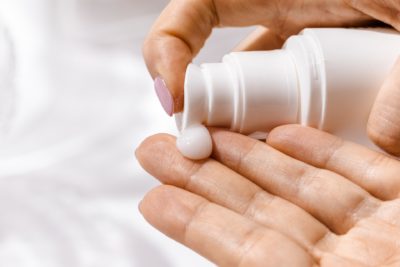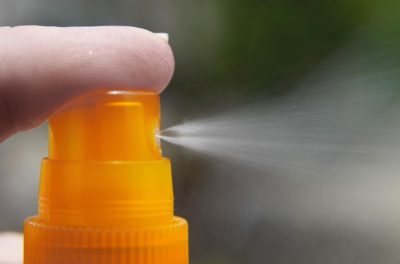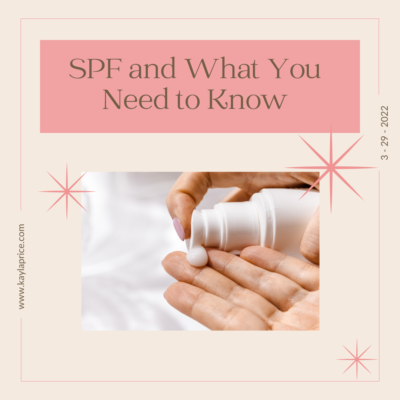
We all know we need to wear sun protection, but do we really understand all the details of why, how, what, etc.? Maybe I am alone, but I am learning that much of what I thought about SPF is wrong.
Several years ago I read that SPF in your make-up is not enough to take care of your skin throughout the day. The article said your sun protection should be a separate step. Being one who wants to protect my skin, I added sunscreen to my morning routine.
I had the confidence that I was doing a good thing and went about my business. Every morning I put my sunscreen on and every night I washed it off. Life was good until I learned that a) I wasn’t applying enough sunscreen in my morning application and b) the morning application was probably not protecting my skin throughout the day.
Part of my confidence in my routine was that not only did I have sun protection from the sunscreen I applied, but it was also in my foundation and maybe a few other products. I felt like I was totally covered. Imagine my surprise when I recently learned that sunscreens don’t have a cumulative effect. They don’t add up to better protection.
At this point, I was totally doubting if I had any sun protection and decided to do a deep dive into the research, and of course, I want to share my findings with you!

Here are a few facts:
- There is no such thing as sunblock (the only way to block the sun’s rays is to be out of the sun). What we put on our skin is sunscreen. The Skin Cancer Foundation recommends that we wear at least SPF 15 every day.
- There are two kinds of UV rays to be concerned with: UVA (which causes premature aging) and UVB (which causes sunburns).
- If a tube of sunscreen does not have an expiration date, consider it expired one year after purchase.
- SPF stands for sun protection factor. The number afterward indicates how much longer it will take for you to burn with the sunscreen than without. SPF 15 means it will take you 15 times longer to burn than if you went out with no protection.
- Broad-spectrum means the sunscreen protects from both UVA and UVB rays, which is preferred.
- To adequately protect the face, 1/4 tsp of sunscreen needs to be applied. To adequately cover your body, 1 ounce of sunscreen is needed.
- Sunscreen should be reapplied every two hours. If sweating, swimming, etc. you will need to reapply more frequently.
- There are two kinds of sunscreen: Mineral/physical and chemical. Mineral sunscreen ingredients, such as zinc oxide, prevent rays from being absorbed into the skin. Chemical sunscreen ingredients absorb the sun’s rays. Though mineral sunscreens are sometimes labeled as organic or natural, they really aren’t any different than chemical other than how they screen out the sun’s rays. Many sunscreens contain both mineral and chemical ingredients, and both types of ingredients are safe to wear. One source I read mentioned that the labels of organic and natural were a marketing ploy.
- Mineral/physical sunscreens zinc oxide and titanium dioxide as well as many other ingredients found in sunscreens can be toxic to sea life. If going in the ocean, sea, river, lake, or pond, use a sunscreen safe for fish and coral. Read the label carefully because sometimes they can be misleading.
- The sun protection in foundation is not adequate for protecting your skin because sunscreen is dose-dependent as mentioned in #5. To get the minimum 1/4 tsp for your face, you would have to apply 6-7 times the amount of foundation you use.
- Sunscreen should have a chance to bond with your skin before being exposed to the sun. Allow 30 minutes. If using an SPF on your face, allow the same amount of time for the SPF to dry before applying foundation.
- Always apply SPF to your entire body each day. Any skin that gets sun exposure needs protection. Examples of parts that don’t generally get covered are a part in hair, ears, neck, back of hands, and top of the forehead. If you have thin hair, you will want to get SPF into any thinning spots such as temples, crown, or hairline.
- SPF in a moisturizer is not recommended as it may reduce the effectiveness of both the moisturizer and sun protectant. It is recommended that separate moisturizer and sunscreen are used.
- There is a preferred order of application for moisturizers and sunscreens. Sunscreen should always be applied last (after serums, moisturizers, etc.) followed by foundation.
- Sunscreens can block pores, so if breakouts are a concern look for oil-free sunscreens.
This is all great information, but you may be sticking on one bit of information if you wear make-up each day. How do you reapply sunscreen if you have a full face of make-up?
For me, the best answer is to use a powder sunscreen such as Colorscience. This product is easy to throw in your handbag since the powder and brush are all-in-one. It makes it easy to reapply sunscreen on the go or at your desk.
Some folks recommend spray sunscreens for reapplication. I am planning to review spray-on sunscreens, so I purchased three or four. Each bottle states that the product should be sprayed on the hand and patted on the face, which defeats the purpose of the spray-on application. The reason is that certain chemicals in spray sunscreens should not be inhaled.
I hope this provided some new information for you as well as a way to follow all the guidelines for protecting your skin from cancer and premature aging. Moms, dads, and caregivers don’t forget to teach your children how important this is for their long-term health. Imagine how much money and time is spent annually on trying to reverse the skin damage done as a young person. Good sun protection is a good investment!
Here are some of my favorite sunscreens:
- Colorscience: https://amzn.to/3L9Msgp
- Neutrogena: https://amzn.to/3itZM31
- EltaMD: https://amzn.to/3unrP9H
- Milk: https://amzn.to/37KOrJw

Visit me at:
YouTube: Kayla Price – YouTube
Instagram: @AtHomeWithKaylaPrice
Pinterest: @AtHomeWithKayla
Twitter: @AtHomeKayla
All items have been purchased and paid for by me. I am including these links for your convenience to find products mentioned. As an Amazon Associate, I earn a small commission from qualifying purchases. This does not increase the price you pay. Any earnings will help me to support and improve my channel.

